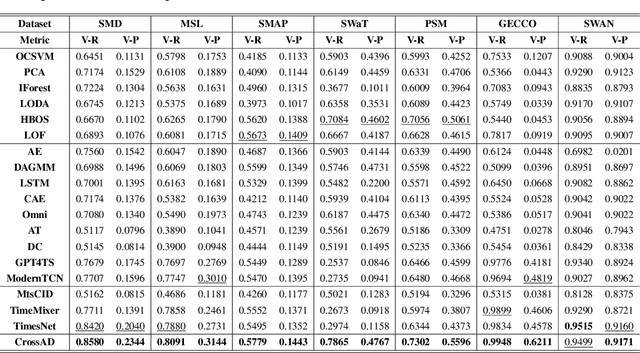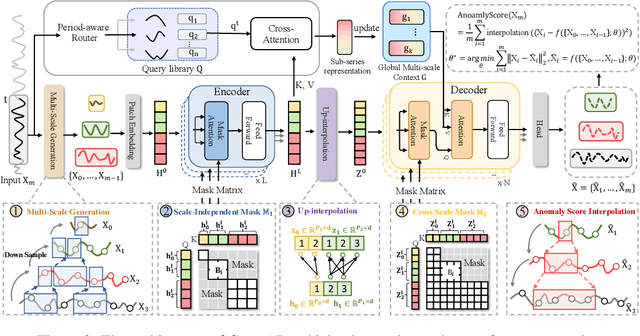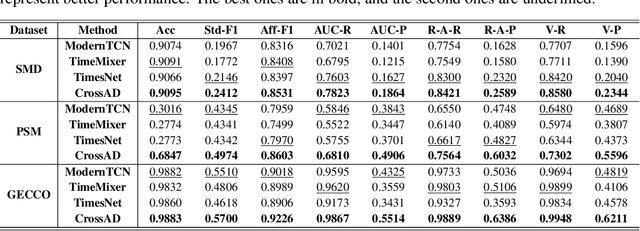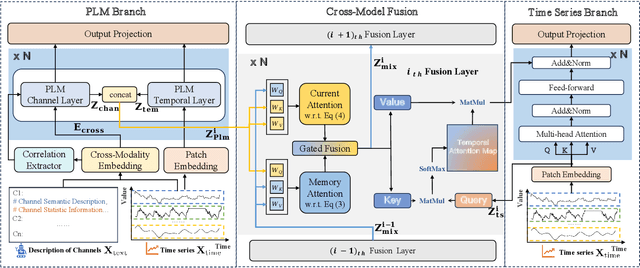Yang Shu
Towards Non-Stationary Time Series Forecasting with Temporal Stabilization and Frequency Differencing
Nov 17, 2025Abstract:Time series forecasting is critical for decision-making across dynamic domains such as energy, finance, transportation, and cloud computing. However, real-world time series often exhibit non-stationarity, including temporal distribution shifts and spectral variability, which pose significant challenges for long-term time series forecasting. In this paper, we propose DTAF, a dual-branch framework that addresses non-stationarity in both the temporal and frequency domains. For the temporal domain, the Temporal Stabilizing Fusion (TFS) module employs a non-stationary mix of experts (MOE) filter to disentangle and suppress temporal non-stationary patterns while preserving long-term dependencies. For the frequency domain, the Frequency Wave Modeling (FWM) module applies frequency differencing to dynamically highlight components with significant spectral shifts. By fusing the complementary outputs of TFS and FWM, DTAF generates robust forecasts that adapt to both temporal and frequency domain non-stationarity. Extensive experiments on real-world benchmarks demonstrate that DTAF outperforms state-of-the-art baselines, yielding significant improvements in forecasting accuracy under non-stationary conditions. All codes are available at https://github.com/PandaJunk/DTAF.
SwiftTS: A Swift Selection Framework for Time Series Pre-trained Models via Multi-task Meta-Learning
Oct 27, 2025Abstract:Pre-trained models exhibit strong generalization to various downstream tasks. However, given the numerous models available in the model hub, identifying the most suitable one by individually fine-tuning is time-consuming. In this paper, we propose \textbf{SwiftTS}, a swift selection framework for time series pre-trained models. To avoid expensive forward propagation through all candidates, SwiftTS adopts a learning-guided approach that leverages historical dataset-model performance pairs across diverse horizons to predict model performance on unseen datasets. It employs a lightweight dual-encoder architecture that embeds time series and candidate models with rich characteristics, computing patchwise compatibility scores between data and model embeddings for efficient selection. To further enhance the generalization across datasets and horizons, we introduce a horizon-adaptive expert composition module that dynamically adjusts expert weights, and the transferable cross-task learning with cross-dataset and cross-horizon task sampling to enhance out-of-distribution (OOD) robustness. Extensive experiments on 14 downstream datasets and 8 pre-trained models demonstrate that SwiftTS achieves state-of-the-art performance in time series pre-trained model selection.
CrossAD: Time Series Anomaly Detection with Cross-scale Associations and Cross-window Modeling
Oct 14, 2025



Abstract:Time series anomaly detection plays a crucial role in a wide range of real-world applications. Given that time series data can exhibit different patterns at different sampling granularities, multi-scale modeling has proven beneficial for uncovering latent anomaly patterns that may not be apparent at a single scale. However, existing methods often model multi-scale information independently or rely on simple feature fusion strategies, neglecting the dynamic changes in cross-scale associations that occur during anomalies. Moreover, most approaches perform multi-scale modeling based on fixed sliding windows, which limits their ability to capture comprehensive contextual information. In this work, we propose CrossAD, a novel framework for time series Anomaly Detection that takes Cross-scale associations and Cross-window modeling into account. We propose a cross-scale reconstruction that reconstructs fine-grained series from coarser series, explicitly capturing cross-scale associations. Furthermore, we design a query library and incorporate global multi-scale context to overcome the limitations imposed by fixed window sizes. Extensive experiments conducted on multiple real-world datasets using nine evaluation metrics validate the effectiveness of CrossAD, demonstrating state-of-the-art performance in anomaly detection.
Aurora: Towards Universal Generative Multimodal Time Series Forecasting
Sep 26, 2025Abstract:Cross-domain generalization is very important in Time Series Forecasting because similar historical information may lead to distinct future trends due to the domain-specific characteristics. Recent works focus on building unimodal time series foundation models and end-to-end multimodal supervised models. Since domain-specific knowledge is often contained in modalities like texts, the former lacks the explicit utilization of them, thus hindering the performance. The latter is tailored for end-to-end scenarios and does not support zero-shot inference for cross-domain scenarios. In this work, we introduce Aurora, a Multimodal Time Series Foundation Model, which supports multimodal inputs and zero-shot inference. Pretrained on Corss-domain Multimodal Time Series Corpus, Aurora can adaptively extract and focus on key domain knowledge contained in corrsponding text or image modalities, thus possessing strong Cross-domain generalization capability. Through tokenization, encoding, and distillation, Aurora can extract multimodal domain knowledge as guidance and then utilizes a Modality-Guided Multi-head Self-Attention to inject them into the modeling of temporal representations. In the decoding phase, the multimodal representations are used to generate the conditions and prototypes of future tokens, contributing to a novel Prototype-Guided Flow Matching for generative probabilistic forecasting. Comprehensive experiments on well-recognized benchmarks, including TimeMMD, TSFM-Bench and ProbTS, demonstrate the consistent state-of-the-art performance of Aurora on both unimodal and multimodal scenarios.
CC-Time: Cross-Model and Cross-Modality Time Series Forecasting
Aug 17, 2025



Abstract:With the success of pre-trained language models (PLMs) in various application fields beyond natural language processing, language models have raised emerging attention in the field of time series forecasting (TSF) and have shown great prospects. However, current PLM-based TSF methods still fail to achieve satisfactory prediction accuracy matching the strong sequential modeling power of language models. To address this issue, we propose Cross-Model and Cross-Modality Learning with PLMs for time series forecasting (CC-Time). We explore the potential of PLMs for time series forecasting from two aspects: 1) what time series features could be modeled by PLMs, and 2) whether relying solely on PLMs is sufficient for building time series models. In the first aspect, CC-Time incorporates cross-modality learning to model temporal dependency and channel correlations in the language model from both time series sequences and their corresponding text descriptions. In the second aspect, CC-Time further proposes the cross-model fusion block to adaptively integrate knowledge from the PLMs and time series model to form a more comprehensive modeling of time series patterns. Extensive experiments on nine real-world datasets demonstrate that CC-Time achieves state-of-the-art prediction accuracy in both full-data training and few-shot learning situations.
LightGTS: A Lightweight General Time Series Forecasting Model
Jun 06, 2025



Abstract:Existing works on general time series forecasting build foundation models with heavy model parameters through large-scale multi-source pre-training. These models achieve superior generalization ability across various datasets at the cost of significant computational burdens and limitations in resource-constrained scenarios. This paper introduces LightGTS, a lightweight general time series forecasting model designed from the perspective of consistent periodical modeling. To handle diverse scales and intrinsic periods in multi-source pre-training, we introduce Periodical Tokenization, which extracts consistent periodic patterns across different datasets with varying scales. To better utilize the periodicity in the decoding process, we further introduce Periodical Parallel Decoding, which leverages historical tokens to improve forecasting. Based on the two techniques above which fully leverage the inductive bias of periods inherent in time series, LightGTS uses a lightweight model to achieve outstanding performance on general time series forecasting. It achieves state-of-the-art forecasting performance on 9 real-world benchmarks in both zero-shot and full-shot settings with much better efficiency compared with existing time series foundation models.
AimTS: Augmented Series and Image Contrastive Learning for Time Series Classification
Apr 14, 2025Abstract:Time series classification (TSC) is an important task in time series analysis. Existing TSC methods mainly train on each single domain separately, suffering from a degradation in accuracy when the samples for training are insufficient in certain domains. The pre-training and fine-tuning paradigm provides a promising direction for solving this problem. However, time series from different domains are substantially divergent, which challenges the effective pre-training on multi-source data and the generalization ability of pre-trained models. To handle this issue, we introduce Augmented Series and Image Contrastive Learning for Time Series Classification (AimTS), a pre-training framework that learns generalizable representations from multi-source time series data. We propose a two-level prototype-based contrastive learning method to effectively utilize various augmentations in multi-source pre-training, which learns representations for TSC that can be generalized to different domains. In addition, considering augmentations within the single time series modality are insufficient to fully address classification problems with distribution shift, we introduce the image modality to supplement structural information and establish a series-image contrastive learning to improve the generalization of the learned representations for TSC tasks. Extensive experiments show that after multi-source pre-training, AimTS achieves good generalization performance, enabling efficient learning and even few-shot learning on various downstream TSC datasets.
Learning Generalizable Skills from Offline Multi-Task Data for Multi-Agent Cooperation
Mar 27, 2025Abstract:Learning cooperative multi-agent policy from offline multi-task data that can generalize to unseen tasks with varying numbers of agents and targets is an attractive problem in many scenarios. Although aggregating general behavior patterns among multiple tasks as skills to improve policy transfer is a promising approach, two primary challenges hinder the further advancement of skill learning in offline multi-task MARL. Firstly, extracting general cooperative behaviors from various action sequences as common skills lacks bringing cooperative temporal knowledge into them. Secondly, existing works only involve common skills and can not adaptively choose independent knowledge as task-specific skills in each task for fine-grained action execution. To tackle these challenges, we propose Hierarchical and Separate Skill Discovery (HiSSD), a novel approach for generalizable offline multi-task MARL through skill learning. HiSSD leverages a hierarchical framework that jointly learns common and task-specific skills. The common skills learn cooperative temporal knowledge and enable in-sample exploitation for offline multi-task MARL. The task-specific skills represent the priors of each task and achieve a task-guided fine-grained action execution. To verify the advancement of our method, we conduct experiments on multi-agent MuJoCo and SMAC benchmarks. After training the policy using HiSSD on offline multi-task data, the empirical results show that HiSSD assigns effective cooperative behaviors and obtains superior performance in unseen tasks.
RCRank: Multimodal Ranking of Root Causes of Slow Queries in Cloud Database Systems
Mar 06, 2025



Abstract:With the continued migration of storage to cloud database systems,the impact of slow queries in such systems on services and user experience is increasing. Root-cause diagnosis plays an indispensable role in facilitating slow-query detection and revision. This paper proposes a method capable of both identifying possible root cause types for slow queries and ranking these according to their potential for accelerating slow queries. This enables prioritizing root causes with the highest impact, in turn improving slow-query revision effectiveness. To enable more accurate and detailed diagnoses, we propose the multimodal Ranking for the Root Causes of slow queries (RCRank) framework, which formulates root cause analysis as a multimodal machine learning problem and leverages multimodal information from query statements, execution plans, execution logs, and key performance indicators. To obtain expressive embeddings from its heterogeneous multimodal input, RCRank integrates self-supervised pre-training that enhances cross-modal alignment and task relevance. Next, the framework integrates root-cause-adaptive cross Transformers that enable adaptive fusion of multimodal features with varying characteristics. Finally, the framework offers a unified model that features an impact-aware training objective for identifying and ranking root causes. We report on experiments on real and synthetic datasets, finding that RCRank is capable of consistently outperforming the state-of-the-art methods at root cause identification and ranking according to a range of metrics.
Assessing Pre-trained Models for Transfer Learning through Distribution of Spectral Components
Dec 26, 2024



Abstract:Pre-trained model assessment for transfer learning aims to identify the optimal candidate for the downstream tasks from a model hub, without the need of time-consuming fine-tuning. Existing advanced works mainly focus on analyzing the intrinsic characteristics of the entire features extracted by each pre-trained model or how well such features fit the target labels. This paper proposes a novel perspective for pre-trained model assessment through the Distribution of Spectral Components (DISCO). Through singular value decomposition of features extracted from pre-trained models, we investigate different spectral components and observe that they possess distinct transferability, contributing diversely to the fine-tuning performance. Inspired by this, we propose an assessment method based on the distribution of spectral components which measures the proportions of their corresponding singular values. Pre-trained models with features concentrating on more transferable components are regarded as better choices for transfer learning. We further leverage the labels of downstream data to better estimate the transferability of each spectral component and derive the final assessment criterion. Our proposed method is flexible and can be applied to both classification and regression tasks. We conducted comprehensive experiments across three benchmarks and two tasks including image classification and object detection, demonstrating that our method achieves state-of-the-art performance in choosing proper pre-trained models from the model hub for transfer learning.
 Add to Chrome
Add to Chrome Add to Firefox
Add to Firefox Add to Edge
Add to Edge